|
At first, let us have a view of the setting sun from a height of
500km at an position somewhere over western india. At 13:02h Greenwhich time
the sun is just shining through the lower atmosphere, touch the earth's surface.
|
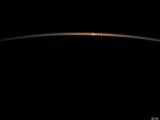
|
|
Three minutes later, at 13:05h UT the sun is below the horizon, while the light
of the backlit amtosphere is still shining at nearly the same intensity as before.
|
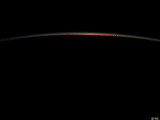
|
|
Moving from the far eastern hemisphere to central europe, we have midday here.
It may be a bright summer day with lots of cumulus clouds, as it is typical
for this region and this time. We view that from a height of 50km above the
earth's surface.
|
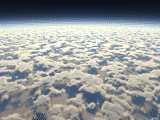
|
|
As we move down we somewhen cross the cloud layer. This image is made when just
above the uppermost clouds.
|
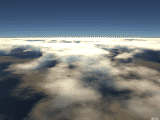
|
|
Now let's go down to the earth. We sit at the geodesic position of Innsbruck,
date is the 1st May 1997, and at 18h local time the sun is still above the horizon,
shining through hazy cloud layers. Of course this are not true tyrolean mountains,
just a fractal composition, but it could be true.
|
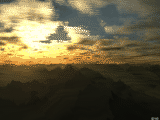
|
|
This is just a zoom into the hazy landscape from above. It nicely shows
backlit clouds flooding over the mountains peak.
|
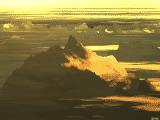
|
|
At early afternoon one might see a sunset in the alps, when the sun is just
setting behind the peak of a high mountain. Such mountains are often called
'Mittagsspitze', 'Mittagskogel' and so on. This example is not so extreme,
as the sun sets at afternoon, not yet at midday. But it also demonstrates
the effect of the high forward scattering in the clear atmosphere, which
is quite prominent at such 'midday sunsets' with relatively high sun altitudes.
In some sense, such a situation could be called a 'small sun eclipse', since
similar effects occur.
|
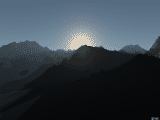
|
|
Now let's have a round look of the local scenery, possible by use of a
fisheye lens projection with a view angle of 180 degrees. The sky is clear,
but from north some clouds seem to come nearer.
(In contrast to reality, also a fisheye lens with 360 degrees or even more
could be used.)
|
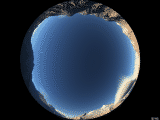
|
|
Just for fun: The above image mapped to a box and a sphere (with the latter
mapping just beeing the inverse of the fisheye view). Not of many sense,
but just a demonstration of the image mapping facility of the light library.
|
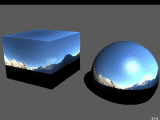
|
|
But let's turn back to the landscape scenery.
Here the valley becomes to be covered with dense, big cumulus clouds.
In nature, this could be a midsummer situation just before
a thunderstorm breaks out.
|
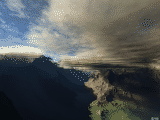
|
|
The next step of thunderstorm generation are more denser clouds.
The landscape becomes quite dark as the sky becomes more and more
covered by the cloud. On nearly expects a lightening which could
occur at any time now. But this is currently out of the simulation
possibilities (but under consideration).
|
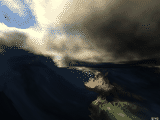
|
|
After the thunderstorm event has gone away, the water which had rained
down onto the mountain evaporates again and forms a new cloud near the
mountains. At the highest regions there might be a new snow layer, now
shining brightly through the ascending cloud.
|

|
|
Let's just have a view into the cloud layer itself, directly to
the sun. One may recognize the bright region around the sun, due to
the high forward scattering property of the cloud particles.
In some cases this region may also contain very colorful parts, due
to diffraction effects of ice crystals within the clouds. This effect
is worth to be spectated in nature, since it is mostly overseen to
its extreme brightness. Rainbowlike effects occure often, in this
case they are called 'Icebows'. In contrast to true rainbows, icebows
do not occure in opposite direction of the sun, but in direction
of the some, some degrees away. Simulation of this effect is under
consideration, but for now nature is the best simulation of itself.
|
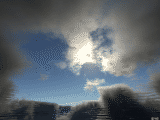
|
|
The view turned back to the mountain, at 17:10h the sun is just before setting
and the clouds are beeing backlit from the low altitude sun. This gives a
deep yellow light, wheras misty veils pass in front of the mountain.
|
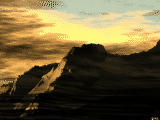
|
|
For the sunset, let's move up to the height of the mountain's peaks
to spectate the last rays of the setting sun.
|
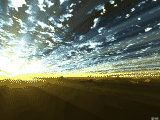
|
|
When the sky is clear at the western horizon, the rays of the low sun may
shine through the lower parts of the atmosphere, which scatters away the
bluish parts of the sunlight, such that only the yellow and reddish component of
the sunlight is able to enlighten the cloud layer. Such spectacular sunsets
are quite rare in nature, since a lot of situations must occur at the
same time (local clouds but clear western sky).
|
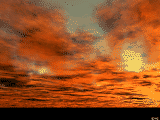
|
|
Some time later, when the sun itself is below the horizon, even the yellow
component might be scattered away, and clouds become deeply red.
|
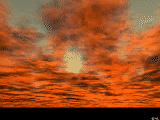
|
|
Now the night comes. The sun is far below the horizon, but is still hight
enough to enlighten the western parts of the atmosphere. Netherless the sky
is dark enough such that stars become visible in the twilight.
|
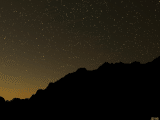
|
|
But when photographing, stars move during the usually long exposure time.
This gives the effect of 'star trails' around the northern celestial pole.
|
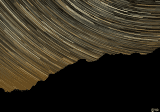
|
|
And last for all people who like these simulations, a high-resolution
image of the setting sun in 1276x351 pixels, generated with Dynamic Antialising
for maximum image quality. Rendering time was more than two weeks on a HP780
Workstation (bau4 from the EDV-Pool),
which has about four times the speed of a Pentium 166MHz PC. (So if you own
a mere 386 PC, downloading the image bitwise might be faster than simulating yourself!)
|

|







































